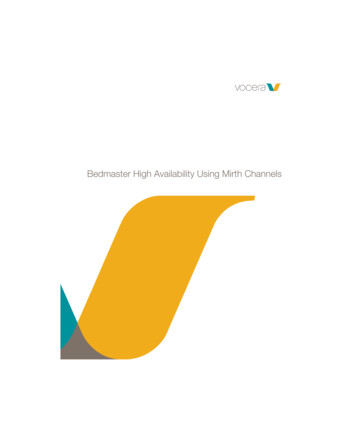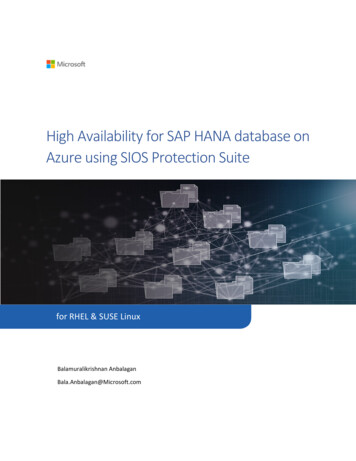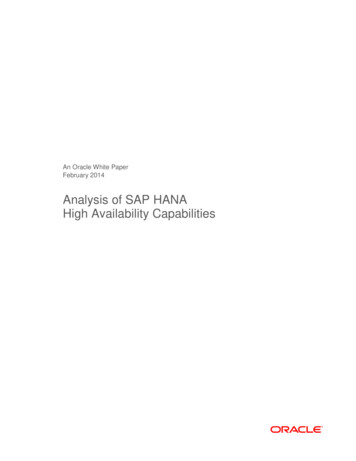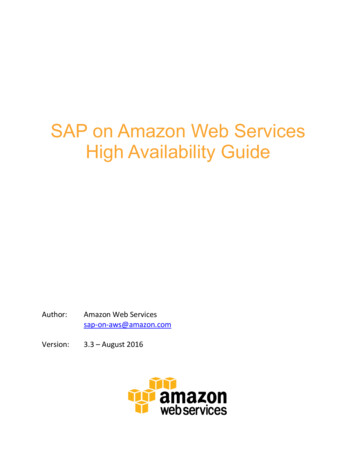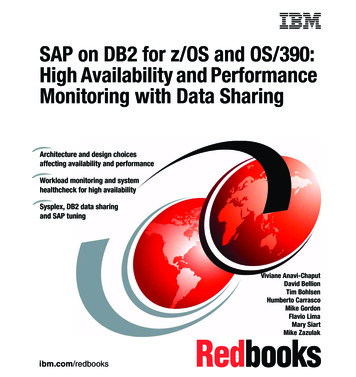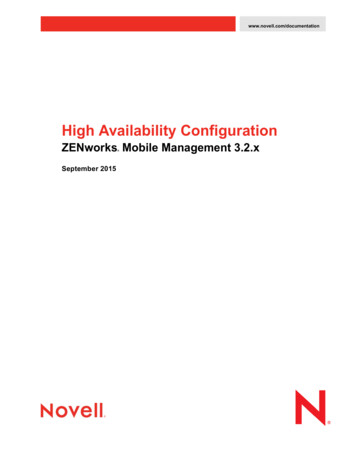
Transcription
Always Up:High Availability Featuresfor Cisco Catalyst 6500/Cisco 7600Switches and RoutersCisco SystemsSeptember 2004prepared for
CONTENTSExecutive Summary . 2Introduction . 5GLBP Baseline Tests . 8NSF/SSO Testing: A Complex Configuration . 11OSPF NSF/SSO Failover. 13BGP NSF/SSO Failover . 22Multicast Multilayer Switching NSF/SSO Failover . 28NSF/SSO Protection for Upper-Layer Services . 32NSF/SSO Failover for Wireless LAN Traffic . 3510GBase-CX4 Throughput. 38Conclusion . 39Acknowledgements . 40About Opus One . 40ILLUSTRATIONSFigure 1: Key Factors for Network Infrastructure . 3Figure 2: Comparing VRRP and GLBP. 6Figure 3: The GLBP Test Bed . 8Table 1: GLBP Failover Tests . 10Figure 4: The OSPF NSF/SSO Test Bed . 13Table 2: Failover With Various Cisco Redundancy Methods. 15Table 3: OSPF NSF/SSO Failover Times . 16Figure 5: OSPF NSF/SSO Traffic Classification, Supervisor 720 . 17Figure 6: OSPF NSF/SSO Traffic Classification, Supervisor 2 . 18Table 4: OSPF NSF/SSO Traffic Classification, Supervisor 720 . 19Table 5: OSPF NSF/SSO Traffic Classification, Supervisor 2 . 19Figure 7: The BGP NSF/SSO Test Bed . 22Table 6: BGP NSF/SSO Failover Times. 23Figure 8: BGP NSF/SSO Traffic Classification, Supervisor 720. 24Figure 9: BGP NSF/SSO Traffic Classification, Supervisor 2. 25Table 7: BGP NSF/SSO Traffic Classification, Supervisor 720 . 25Table 8: BGP NSF/SSO Traffic Classification, Supervisor 2 . 26Table 9: BGP NSF/SSO VoIP Traffic Handling . 27Figure 10: MMLS/NSF/SSO Failover Test Bed . 28Figure 11: MMLS/NSF/SSO Failover for Supervisor 720 . 30Table 10: MMLS/NSF/SSO Failover Times . 31Table 12: NSF/SSO Supervisor Failover With Long-Lived HTTP Sessions. 33Table 13: NSF/SSO Supervisor Failover With Long-Lived HTTP and HTTPS Sessions34Figure 12: WLSM with NSF/SSO Failover Test Bed. 36Figure 13: WLSM Failover With NSF/SSO . 37Table 13: 10GBase-CX4 Performance. 38Page 2 of 40
Executive SummaryHigh availability ranks among the top network infrastructure requirements – more so thansecurity, standards support, performance, or even price. There’s good reason for this kindof thinking: High availability features increase uptime and prevent losses in productivityand revenue.A recent study by Infonetics Research makes clear the importance of high availabilityfeatures. When asked to name their top requirements for WAN and Internetinfrastructure, network managers rated high availability well ahead of nearly all otherfactors1. Figure 1 below presents results from the Infonetics study.Figure 1: Key Factors for Network Infrastructure70%Percentage of respondents rating 6 or cesSU/DCSUatgrtePackedetizedMvoiPLceS0%Cisco Systems is addressing the requirement for resilient network infrastructure byadding several new features to its Cisco Catalyst 6500 series switches and Cisco 7600series routers – Gateway Load Balancing Protocol (GLBP), Non-Stop Forwarding (NSF),and Stateful Switchover (SSO). These features ensure greater uptime with no loss infunctionality of existing switch or router features.Cisco commissioned Opus One, an independent networking consultancy, to conductperformance tests measuring the effectiveness of Cisco’s new resiliency mechanisms.1Infonetics Research, User Plans for WAN and Internet Access, US/Canada, 2003.Page 3 of 40
Opus One not only tested each resiliency mechanism, but also applied many of thefactors at work in large enterprise settings: Unicast and multicast traffic; voice over IPtraffic; Policy Based Routing; QoS enforcement; attacks using spoofed IP addresses; andvery large access control lists. In addition to the resiliency tests, Opus One tested Cisco’snew 10GBase-CX4 interfaces, a cost-effective new standard for running 10-gigabitEthernet over copper.Among the key findings of Opus One’s tests: NSF/SSO provides zero packet loss on any of 4 million flows despite the loss of aSupervisor Engine card and 10,000 OSPF routes when line cards are equippedwith Distributed Forwarding Card (DFC) modules NSF/SSO provides zero packet loss on any of 4 million flows despite the loss of aSupervisor Engine card and 10,000 BGP routes when line cards are equipped withDistributed Forwarding Card (DFC) modules No loss in functionality during or after Supervisor Engine failure for any of thefollowing features: Policy Based Routing, access control lists, rate limiting, andUnicast Reverse Path Forwarding (uRPF, which protects against the use ofspoofed IP addresses in DoS attacks) Thanks to enhanced wiring-closet device resilience provided by Cisco's newGateway Load-Balancing Protocol (GLBP), first-hop router or switch recovery of2.01 seconds or less Perfect load balancing across protected VLANs and subnets using GLBP, makingfull use of two uplinks to each wiring closet and doubling capacity compared withVRRP NSF/SSO failover times are virtually identical with unicast and multicast traffic,even when 10,000 s,g mroutes are involved Minimal degradation of voice over IP audio quality during Supervisor Enginefailover NSF/SSO protects upper-layer session state through tight integration with otherservices modules for Cisco Catalyst switches NSF/SSO delivers high availability to wireless as well as wired clients throughtight integration with the new Wireless LAN Services Module (WLSM) for CiscoCatalyst 6500 series switches Line-rate throughput for the new 10GBase-CX4 interfacesPage 4 of 40
These results underscore the ability of Cisco Catalyst 6500 series switches and Cisco7600 series routers to deliver near-perfect uptime, despite the loss of a Supervisor Enginecard.This report is organized as follows. An introduction describes the various highavailability mechanisms tested. Then we move on to discuss test bed configuration,procedures and results from tests of GLBP, NSF/SSO with OSPF, NSF/SSO with BGP,and NSF/SSO with IP multicast traffic.IntroductionOur tests focused on three of Cisco’s resiliency features for Cisco Catalyst 6500 seriesswitches and Cisco 7600 series routers: the Gateway Load Balancing Protocol (GLBP),Non-Stop Forwarding (NSF), and Stateful Switchover (SSO). We also benchmarked theperformance of new 10Gbase-CX interfaces, which give the Cisco Catalyst 6500 andCisco 7600 10-gigabit-Ethernet-over-copper capability.The Gateway Load Balancing Protocol is a patent-pending evolution of Cisco’s HotStandby Router Protocol (HSRP). With first-hop router redundancy protocols such as theVirtual Router Redundancy Protocol (VRRP) or Cisco’s Hot Standby Routing Protocol(HSRP), only a single “active forwarder” is permitted per protected subnet/VLAN2. Inaddition, VRRP permits only one of the two uplinks from each wiring closet to be active;the other is held in standby mode and cannot be used to carry traffic.GLBP, in contrast, allows the use of both redundant uplinks during normal operation.This allows both GLBP routers to be "active forwarders" simultaneously. With GLBP,both GLBP routers are active in the routed topology. The rest of the network will seeequal-cost paths to the protected subnet, and traffic to that subnet is load-balanced acrossthe two routers. In the reverse direction, a patent-pending method load-balances trafficfrom end-stations between the two GLBP routers. With GLBP, failover times areconfigurable.The net result: GLBP doubles available bandwidth while allowing users to deploy asingle subnet in the wiring closet.GLBP can be said to be an “active-active” protocol, while VRRP is an “active-passive”protocol. VRRP supports a single active uplink from the wiring closet at any one time.GLBP, in contrast, makes use of both uplinks during normal operation. Further, itbalances the load across uplinks. Our test results confirmed that GLBP distributes loadsevenly across links. In fact, the load was so evenly distributed in our tests that interfacecounters on each of two Cisco Catalyst switches running GLBP matched to the packet.2RFC 3768 describes VRRP, while RFC 2281 describes HSRP.Page 5 of 40
Figure 2 below compares forwarding paths for VRRP (on the left) and GLBP (on theright.)Figure 2: Comparing VRRP and GLBPCoreCoreCoreUplink B0%Uplink A100 %CoreUplink B50 %Uplink A50 %L2 wiring closet switchL2 wiring closet switchVRRPGLBPGLBP also enhances routing resiliency. If one GLBP router fails, another is instantly ableto forward traffic to/from the core network since its routing adjacencies are alreadyestablished. This is not the case with VRRP.Non-Stop Forwarding (NSF) makes use of the industry-standard graceful restartmechanisms developed by the IETF. It preserves layer-3 forwarding state during the lossand restart of a routing session, as might occur due to the failure of a Supervisor card.Without NSF, reconvergence after loss of a routing session may take tens of seconds oreven minutes. For example, the OSPF routing protocol’s default timer values require 40seconds to pass before a router will declare a routing session to be dead. Then a newrouting session must be re-established, followed by a potentially lengthy exchange ofrouting updates.Our tests show that NSF can reduce this interval to 2 seconds or less for packets centrallyswitched by the failed Supervisor Engine card, or zero loss if NSF/SSO is used inconjunction with line cards equipped with Cisco’s Distributed Forwarding Card (DFC)modules.Page 6 of 40
Cisco’s NSF works with EIGRP, BGP, OSPF, and IS-IS. We used OSPF and BGP inthese enterprise-focused tests.Stateful Switchover (SSO) is Cisco’s method of preserving layer-2 forwarding statedespite the failure of a Supervisor Engine card. SSO synchronizes layer-2 forwardingtables and spanning tree topology state between redundant Supervisor cards in the samechassis. This ensures forwarding will continue even after the loss of an active Supervisorcard, and that no spanning tree topology change will be triggered by the failover to thestandby Supervisor.Page 7 of 40
GLBP Baseline TestsThe Gateway Load Balancing Protocol feature of Cisco IOS provides both fault toleranceand load-sharing, something we demonstrated in tests involving multiple failurescenarios. As noted in the introduction, GLBP improves on existing redundancytechnologies like Virtual Router Redundancy Protocol (VRRP) by providing “activeactive” rather than “active-standby” availability of redundant routers.Figure 3 below illustrates the test bed used in the GLBP baseline tests. Four CiscoCatalyst 6500 switches – designated A, B, C, and D – are interconnected with 10-gigabitEthernet circuits.3 While we used Cisco Catalyst switches for this project, the samefeatures are available on Cisco 7600 series routers.Figure 3: The GLBP Test BedSmartBitsTeraRoutingVLAN 110192.85.1.0/2440 hosts per port160 hosts totalL210GEC6509(A)10GEGLBP VIP 192.85.1.1L3L3C6509(C)C6509(B)10(Co G Epper)C6509(D)L3G10E2,500 OSPF networks per port10,000 OSPF networks totalSmartBitsTeraRouting3We used Cisco Catalyst 6500 series switches for these tests, but all test results in thisdocument apply equally to Cisco 7600 series routers. Any references to Cisco Catalystswitches in text cover the Cisco 7600 series routers as well.Page 8 of 40
Switch A represents a layer-2 wiring-closet device. Behind it, a SmartBits trafficanalyzer/generator offers traffic from 40 emulated hosts on each of four switch ports, fora total of 160 emulated hosts. The interfaces linking Switch A with Switches B and Cshare a common VLAN ID.Switches B and C represent redundant layer-3 devices at the core of the network. Thesetwo GLBP-enabled routers share a single virtual IP address used by end-stations(emulated by the SmartBits) as their default gateway. By responding to end-station ARPrequests with alternating MAC addresses representing Switch B or C, GLBP directs endstations to use one or the other GLBP router as their default gateway. In this way, trafficfrom the end-stations is balanced evenly across the A-B and A-C links. This virtual IPaddress is in the same VLAN and IP subnet as the end-stations being protected by GLBP.Switch D represents another layer-3 core device with a large number of networks behindit. A SmartBits attached to Switch D establishes OSPF adjacencies and advertises 2,500networks behind each of four interfaces, for a total of 10,000 networks.We offered test traffic to four ports on Switch A, destined to all 10,000 networks beyondSwitch D, at a rate of 1 million packets per second. At that rate, each dropped packetrepresents 1 microsecond of failover time.We ran this test multiple times: First as a baseline case with no failure to verify thatGLBP load-balanced traffic as claimed, and then with separate failover test casesinvolving a link failure and failures of the Supervisor 720 card in Switch B and theSupervisor 2 card in Switch C.By testing both Supervisor 720 and Supervisor 2 scenarios, we covered the major portionof Cisco's installed base of users. This validated the functionality of GLBP in eitherenvironment, or indeed in a hybrid network as used in these tests.In the no-failure baseline, we verified that the system under test could forward to all portsat 1 million packets per second with zero loss. This test also determined that GLBPbalanced the load across the A-B and A-C links.We verified load balancing using the Cisco Catalyst 6500 port counters, which showeduniform distribution of packets across the two paths. We then verified the accuracy of theCisco Catalyst port counters by comparing them with SmartBits transmit and receivecounters. All the counters matched: Load balancing was perfect across the A-B and A-Clinks.Next, we offered the same traffic and tested the effects of link failure. Approximately 30seconds into the 60-second test, we physically disconnected the A-C link, forcing GLBPto redirect all traffic onto the A-B link.GLBP worked correctly here: All traffic arrived at the destination ports with zero lossdespite the loss of the A-C link. Since ample bandwidth existed on the A-B link to carryPage 9 of 40
traffic redirected from the A-C link, zero loss was the expected result. We noted thatthere was no routing protocol convergence needed on Switch B, allowing traffic to beforwarded with no delay.In the next test case, we forced a Supervisor card failure by removing the activeSupervisor 720 card from Switch B approximately 30 seconds into the test. This removalforced GLBP to redirect traffic onto the A-C link and through Switch C. In three trials,the failover took an average of 1.2 seconds. This test result represents the time needed forflows to be redirected and switched through Switch C.We then repeated the test while removing the active Supervisor 2 card from Switch C,thus forcing the system to redirect traffic via Switch B. This time, the failover took anaverage of 2.0 seconds over three trials.Table 1 below summarizes results from the GLBP failover tests.Table 1: GLBP Failover TestsTest caseGLBP, Supervisor 720card failure in Switch BGLBP, Supervisor 2 cardfailure in Switch CFailover time (seconds)1.2078042.016601Page 10 of 40
NSF/SSO Testing: A Complex ConfigurationLarge-scale enterprise networks are anything but simple, and we used an accordinglycomplex setup in our NSF/SSO tests. The test bed configuration modeled many aspectsof large-scale production networks, involving not only multiple OSPF areas or BGPautonomous systems, but also many other factors that can affect network performance.The features simultaneously active in this test included all of the following:Policy-Based Routing (PBR). It is often desirable for administrative or technicalreasons to override OSPF or BGP shortest-path calculations and force sometraffic to use “high-cost” links. For this event, the Cisco Catalyst 6500 switcheswere configured to enforce PBR on a subset of test traffic. The expected resultwas that the switches would continue to enforce policy during and after a failover,sending specified traffic – and only specified traffic – over a high-cost link.Access Control Lists (ACLs). We used a 10,000-line access control list in thistest. That is considerably larger than the ACLs in use at even many largeorganizations, and thus considerably more stressful a test case.The 9,999th rule required routers to discard all test traffic with a particulardestination IP address and TCP port number. Placing this rule at the bottom of thelist forced the switches to compare every packet to nearly 10,000 entries beforemaking a forwarding decision.The expected result was that the switches would drop all traffic matching the9,999th rule during and after failover, demonstrating that ACLs remain in effect atall times. To simplify results tracking, we configured the Spirent SmartBits trafficgenerator/analyzer to send all traffic matching the 9999th rule to a singledestination interface. Therefore, we expected one SmartBits interface to receivezero packets before, during, and after a failover.Unicast Reverse Path Forwarding (uRPF). Denial-of-service and other attackscommonly originate from spoofed IP addresses. Tracing spoofed addresses totheir actual origin can be quite difficult. If a packet with a spoofed addressoriginates from a directly attached subnet, ACLs can help by blocking traffic notoriginating from that subnet. However, such ACLs do nothing to stop forgedpackets sourced from one or more hops away.Cisco’s ha
Gateway Load-Balancing Protocol (GLBP), first-hop router or switch recovery of 2.01 seconds or less Perfect load balancing across protected VLANs and subnets using GLBP, making full use of two uplinks to each wiring closet and doubling capacity compared with VRRP NSF/SSO failover tim

